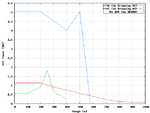Good evening all
Just a quick question to the experts and general groups out there. Our historical gaiming group is having a discussion about if centerline guns such as those in the P38 had an appreciable effect upon the damage delivered as opposed to wing and or/ combination mounted guns. Any comments or data would be useful.
Thanks
Dan
Just a quick question to the experts and general groups out there. Our historical gaiming group is having a discussion about if centerline guns such as those in the P38 had an appreciable effect upon the damage delivered as opposed to wing and or/ combination mounted guns. Any comments or data would be useful.
Thanks
Dan

